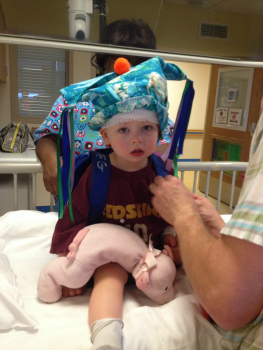
Jake's Story

 When Jake Brady was born, he was a normal, happy baby. He did seem to be hitting his development milestones a little late, but his parents weren’t worried. When he was 10 months old, his parents, Trisha and Jason Brady, noticed what they now realize was Jake’s first seizure.
When Jake Brady was born, he was a normal, happy baby. He did seem to be hitting his development milestones a little late, but his parents weren’t worried. When he was 10 months old, his parents, Trisha and Jason Brady, noticed what they now realize was Jake’s first seizure.
“At the time, we just thought Jake was really sleepy, and his pediatrician didn’t seem concerned either,” Trisha said. “Then it progressed over the next few months, and we became alarmed. Jake would be crawling, and then, all the sudden, his head would go limp and hit the ground.”
Jake’s parents took him back to his pediatrician who said she thought Jake might be having seizures.
“This moment is when it all clicked, and we realized what had been happening to Jake over the past few months,” Trisha said.
After seeing a general pediatric neurologist, Jake’s parents took him to Andrea Gropman, M.D., a pediatric neurologist and Division Chief of Neurodevelopmental Disabilities and Neurogenetics at Children’s National Hospital, who quickly ordered a video electroencephalogram (EEG) for Jake as well as a lumbar puncture (spinal tap) and magnetic resonance imaging (MRI). Jake was hospitalized for a few days for these tests.
“We were terrified. We had never been to a children’s hospital and were nervous about all the tests Jake had to go through, wondering if they were really needed,” Trisha said. “But now we are so glad we did all the tests and really trusted our care team. We wouldn’t have figured out what was wrong with Jake if his doctors didn’t have the foresight to order these tests.”
During Jake’s first hospital stay, Dr. Gropman and her team diagnosed Jake with epilepsy and put him on Topamax®, a common anti-seizure drug to help manage his seizures.
After Jake was discharged, his general pediatric neurologist continued to follow him and helped the family gradually adjust Jake’s medication until he became seizure-free.
“I will never forget that first day Jake was seizure-free. It was a miracle for our family,” Trisha said.
Jake was two years old at this point and was taking high dosages of both Topamax® and Keppra® to keep his seizures at bay.
“Jake was developmentally very behind. He was walking a little, but he was behind. We were a little worried this was due to his medications, but our main priority was to keep his seizures away,” Trisha said.
 Over the next few months, Jake continued to visit both his general pediatric neurologist and Dr. Gropman. The spinal tap when he was first hospitalized had suggested an underlying diagnosis, and Dr. Gropman ordered genetic testing that confirmed he has glucose transporter type 1 deficiency syndrome (Glut1 DS). Glut1 DS is a rare genetic disorder in which glucose is not adequately transported from the bloodstream into brain cells. This condition can cause seizures, movement disorders, and developmental delays.
Over the next few months, Jake continued to visit both his general pediatric neurologist and Dr. Gropman. The spinal tap when he was first hospitalized had suggested an underlying diagnosis, and Dr. Gropman ordered genetic testing that confirmed he has glucose transporter type 1 deficiency syndrome (Glut1 DS). Glut1 DS is a rare genetic disorder in which glucose is not adequately transported from the bloodstream into brain cells. This condition can cause seizures, movement disorders, and developmental delays.
“I was shocked and very scared when we found out Jake has Glut1,” Trisha said, “We had never heard of this type of epilepsy before, but I started Googling it and was devastated by how serious it sounded.”
Amy Kao, M.D., a neurophysiologist in the Comprehensive Pediatric Epilepsy Program, met with Jake and his parents to help them learn more about the ketogenic diet (“keto diet”), which is the only approved treatment for this condition. The keto diet is a high-fat, low-carbohydrate diet that forces the body to burn fats rather than carbohydrates.
“At first, we couldn’t believe a diet could help Jake’s condition. It just seemed too crazy and too hard,” Trisha said. “But my husband and I decided we would commit to trying it for two months.”
Jake and his parents spent Jake’s first week on the keto diet in the hospital so he could be monitored for complications due to the sudden change in his body’s metabolism, while Dr. Kao and her team educated the family about the diet.
 “We saw big changes within a month of Jake being on the keto diet and were just so relieved,” Trisha said. “It is truly amazing. We’ve been following the diet for two years now, and it’s been a game-changer for us.”
“We saw big changes within a month of Jake being on the keto diet and were just so relieved,” Trisha said. “It is truly amazing. We’ve been following the diet for two years now, and it’s been a game-changer for us.”
Jake’s favorite keto foods are pizza, goldfish, chips, burgers, quesadillas, and ice cream. Trisha said, “I think one of the reasons we are so successful with the diet is that we work really hard at making Jake food that looks like what everyone else has. His preschool sends home monthly food menus, and we prepare his lunch each day to mimic exactly what they are having, keto style.”
Over the course of two years on the keto diet, Jake has continued to be seizure-free, with normal EEGs, and has been able to successfully wean off of the majority of his medications. Today, Jake is an energetic 4-year-old who loves cars, trucks, football, and playing with his two dogs. He is looking forward to starting kindergarten next fall.
“Once Jake started weaning off of his medications, we were shocked that the diet seemed to sustain him and continue to keep his seizures away. We’d recommend it to anyone in our situation,” Trisha said. “After Jake got off of his medications, he started progressing a lot faster developmentally and physically. He’s completed his physical therapy, loves racing us and running around, and just learned how to jump, which is very exciting.”



